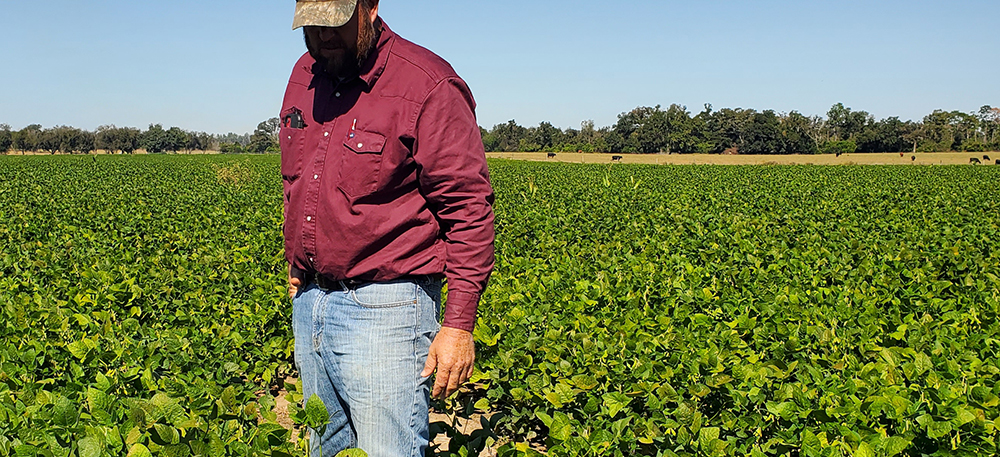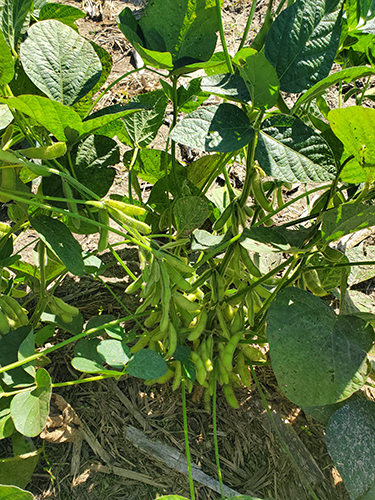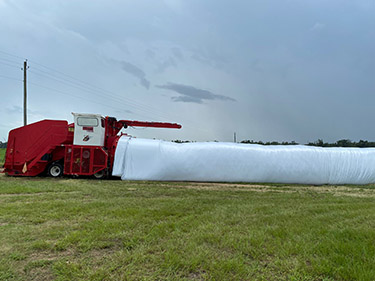
Forage Soybeans Rate a Look
Florida demonstration finds high-protein, high-fat feedstuff grown and harvested for $91 per ton as fed.
No doubt you got the memo. Paying the feed bill is painful. To add to the stress level, supply chain issues make availability a dicey proposition. As a result, University of Florida (UF) cattle nutrition specialist Nicolas DiLorenzo is looking at nontraditional feeds. Last summer, it was silage made from forage soybeans.
“With the development of new varieties, we decided it was time to reevaluate its potential as a silage crop,” DiLorenzo says.
To keep it simple and timely, he did a demonstration rather than a full-scale research trial.
July 23, 2022, he and his co-workers planted 35 acres of forage soybeans (Large Lad®, Eagle Seeds Co.) under irrigation at the North Florida Research and Education Center (NFREC) in Marianna. It was a prime example of efficient land use — the soybean seed was drilled directly in the residue of a corn crop that was harvested as silage in mid-July. They fertilized with 100 units of potash, 40 units of phosphorus and 60 units of nitrogen. Later in the growing season, they sprayed twice with boron, and sprayed a herbicide (glyphosate) and an insecticide (Besiege®, Syngenta) for the control of worms. With seed costs of $38 an acre, fertilizer, herbicide and insecticide, as well as planting and scouting, the total cost in 2022 was $343 an acre.
On Oct. 27 they harvested 6 tons of green-chop silage per acre for a total cost of $57 a ton. Total harvest costs were $34 a ton, which included mowing, chopping and bagging. The total harvest from the 35 acres was 210 tons of forage soybeans with 36.7% dry matter. With the cost of growing the crop plus harvesting it, the total cost was $91 per ton as fed, or $249 per ton of dry matter.

cutline [Photo credit] |
Nutritive value
After the forage soybeans were ensiled for more than 90 days, a feed analysis was done by a commercial lab. On a dry-matter basis, the nutrient content was 18% crude protein (CP), 8.9% crude fat, 3.4% starch, 30.2% neutral detergent fiber (NDF), 27% ash, and 57% total digestible nutrients (TDN).
“Those last two values were a bit surprising,” says DiLorenzo. He speculates they set the cutting height too low to try to get as many of the pods as possible. However, he adds, “It is rare to see soybean silage exceed 60% TDN on a dry-matter basis.”
Lessons learned
After their first go at ensiling forage soybeans at NFREC, DiLorenzo recommends:
- If possible, plant earlier than late July to maximize the harvest yield. “I think the optimal time to plant is probably May or June, but for planting as a following crop, mid-July is probably fine.”
- Research the best variety to plant. The differences in germplasm can greatly affect crop performance.
- Adjust the cutting height to avoid harvesting soil and diluting the energy.
- Harvest when the bottom leaves begin turning yellow to maximize yield and quality.
- Use an inoculant designed for legumes to help in fermentation and minimize losses, particularly during the feedout phase.
Take-home message
“No doubt, $249 per tons of dry matter is a large investment,” says DiLorenzo. However, he says, the cost looks better when it is put in terms of 77 tons of high-quality forage dry matter with 18% crude protein and 8.9% fat harvested in one day from 35 acres. Better yet, the silage was stored in an 84-foot (ft.)-long by 12-ft.-diameter silage bag, eliminating the need for a silo.

cutline [Photo credit] |
DiLorenzo emphasizes this was a demonstration, not a research study; and more research needs to be done on optimal planting dates, fertilization rates, production timing, and cost of production. However, he adds, given the price of protein supplements, the practice of ensiling forage soybeans rates another look.
“Initially, I was very skeptical; but there might be room for ensiled forage soybeans,” says the UF animal scientist. “We don’t get much growing in the Southeast with that kind of protein. It could be a substitute for distillers’ grain.” He adds that ensiled forage soybeans would probably work best for growing cattle, possibly mixed 50:50 with corn silage.
Editor’s note: Becky Mills is a freelance writer and cattlewoman from Cuthbert, Ga. [Lead photo by Nicolas DiLorenzo.]



